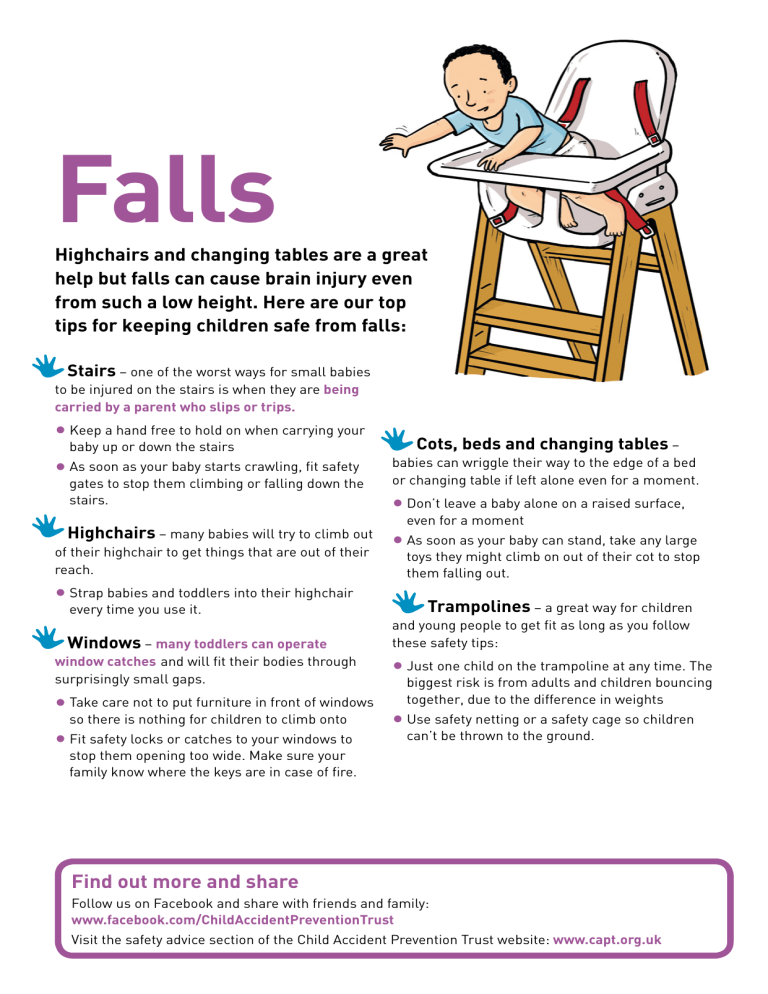
Falls Highchairs and changing tables are a great help but falls can cause brain injury even from such a low height. Here are our top tips for keeping children safe from falls: Stairs – one of the worst ways for small babies to be injured on the stairs is when they are being carried by a parent who slips or trips. • Keep a hand free to hold on when carrying your baby up or down the stairs • As soon as your baby starts crawling, fit safety gates to stop them climbing or falling down the stairs. Highchairs – many babies will try to climb out of their highchair to get things that are out of their reach. • Strap babies and toddlers into their highchair every time you use it. Windows – many toddlers can operate window catches and will fit their bodies through surprisingly small gaps. • Take care not to put furniture in front of windows so there is nothing for children to climb onto • Fit safety locks or catches to your windows to Cots, beds and changing tables – babies can wriggle their way to the edge of a bed or changing table if left alone even for a moment. • Don’t leave a baby alone on a raised surface, even for a moment • As soon as your baby can stand, take any large toys they might climb on out of their cot to stop them falling out. Trampolines – a great way for children and young people to get fit as long as you follow these safety tips: • Just one child on the trampoline at any time. The biggest risk is from adults and children bouncing together, due to the difference in weights • Use safety netting or a safety cage so children can’t be thrown to the ground. stop them opening too wide. Make sure your family know where the keys are in case of fire. Find out more and share Follow us on Facebook and share with friends and family: www.facebook.com/ChildAccidentPreventionTrust Visit the safety advice section of the Child Accident Prevention Trust website: www.capt.org.uk Falls Falls down stairs can damage babies’ and children’s brains as well as their bodies. Activity ideas • Use window catches and a doll and toy changing mat to highlight these fall risks. These props could also help you to open up discussions about other fall risks, such as falls on stairs and falls from trampolines. • If you’re working with families of older children, arrange a talk and demonstration from a local martial arts instructor. They can teach children how to fall safely and avoid serious injuries when climbing and playing in parks and playgrounds. • Get a group of parents together and show films from CAPT’s Look who’s falling DVD. This highlights three typical accidents and comes complete with discussion guides and take away flyers for parents on how to prevent serious falls in the home. • Encourage parents to think about the next stage in their child’s development, such as rolling, crawling, standing and climbing, and how their child may surprise them. CAPT’s guide Accidents and child development will show you how accidents are linked to child development. CAPT resources for your event • Look who’s falling DVD resource pack • How safe is your child from a serious fall? leaflet • How safe am I from a serious fall? flyer • I can easily fall down the stairs poster • Toddlers and up top safety tips leaflet • 5-7s top safety tips leaflet • 7-11s top safety tips leaflet • As I grow and change I can... pictorial booklet • Preventing accidents session plans – contains dedicated session plans on: • Falling on the stairs • Falling out of the highchair • Falling from an open window Available from CAPT’s online shop www.capt.org.uk/shop Useful links CAPT’s Making the Link site has an interview with consultant paediatric neurologist Dr Andrew Curran from Alder Hey Children’s Hospital. He talks about the emotional and economic impact on families of caring for a child with a head injury: www.makingthelink.net/tools/head-injuries
